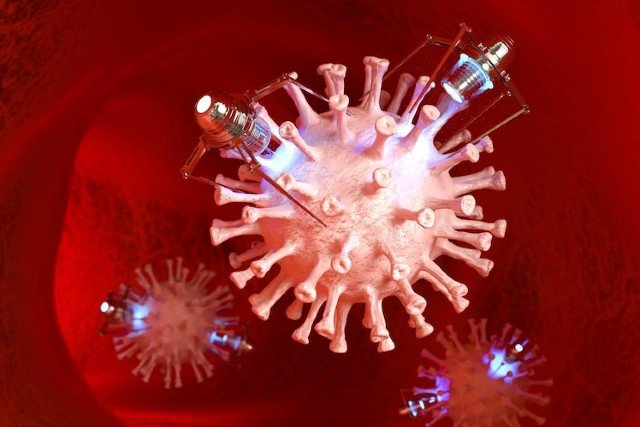Nanomedicine is the technology of nanotechnology. It is used to achieve innovation in healthcare. It is developed by a material at its nanometric scale 10-9. It is different in every term like physics, chemistry or biology. It is used by same material at bigger scale. The size of nanometric is also scale of many biological mechanisms in the human body. It allows nanoparticles and nanomaterials to potentially cross natural barriers. It can access new sites of delivery.
It can also interact with DNA or small proteins at different levels for example, in blood or within organs, tissues or cells. If we talk about nano-scale, the surface-to-volume ratio is becoming an intrinsic parameter of the potential actions of a particle or material. If we talk about Coating of the particles and functionalization of their surfaces (even on multiple levels), they are extremely common. They can increase the biocompatibility of the particle and its circulation time in the blood. It can ensure a highly selective binding to the desired target.
You should visit nanomedicine examples website for more information. They have well knowledge about this.
It has the potential. It can enable detection and prevention. It improves diagnosis, treatment and follow-up of many diseases in which included cancer. It has hundreds of products under clinical trials. These products are covering major diseases for example cardiovascular, neurodegenerative, musculoskeletal and inflammatory. theranostic nanoparticles .It is accounting for approximatively 80 marketed products, ranging from nano-delivery and pharmaceutical to medical imaging, diagnostics and biomaterials.
If we talk about the history of nanomedicine dates back to 1959, Physicist Richard Feynman first introduced the concept of nanotechnology. In 1974, the Japanese scientist Norio Taniguchi coined the term nanotechnology.
Nanomedicine impacts all fields of medicine
It is a key enabling instrument for personalized, targeted and regenerative medicine. It is delivering the next level of new drugs, treatments and implantable devices. It is used for clinicians and patients, for real breakthroughs in healthcare.
It provides important new tools. It can deal with the grand challenge of an ageing population. It is a instrumental for improved and cost effective healthcare. It is a crucial factor for making medicines. The treatments available and it is affordable for all.
The challenge of unmet medical needs
There are thousands of diseases in the world and the human are still fighting against a high number of serious and complex illnesses like cancer, cardiovascular diseases, multiple sclerosis, Alzheimer’s and Parkinson’s disease, and diabetes. They are also facing different kinds of serious inflammatory or infectious diseases (e.g. HIV). There are many theses diseases which can negatively impact on patient. These diseases can also negatively impact on whole society and linked social and insurance systems.
Nanomedicine is rising very high for millions of patients for better, more efficient and affordable healthcare. The website we suggested has potential of delivering promising solutions to many illnesses.
There are many diseases which treat through surgery and chemotherapy or regenerative medicine and nanotechnologies. This can impact on all fields of current medicine. There are many medical care areas which are benefiting from the advantages. The first target of nanotechnology-based is drug delivery systems on the market and the others are clinical trials or, by far the largest part. The highly attractive area of nanomedicine is diagnostics at nanoscale.
The main thing is to identify the disease at the earliest possible stage. The single cell with ill behavior would be detected and cured or eliminated. The medicine will be given to many patients to build hope. It will also be given to organ failure or severe injuries. Now a day’s artificial skin, bone and cartilage are in an advanced stage of development.
Nanomedicine… is nano in medicine!
If we talk about promising possibilities of nanomedicine, it offers in the future. It has to be counterweighted against risks. The safety of it is like drugs and medical devices, clinically. It is evaluated for their benefit/risk ratio for the patients. If we talk about any medical devices or drugs, nanomedicine, they have to follow thorough characterization, toxicity assessment and multi-stage. There is possible of side effects to human beings and the environment. There are several European projects which are dealing with this highly important issue. The social acceptance and ethical concern will have to be taken into account.
For what diseases it is being used?
It is being used for many diseases some of them are given below
- Cancer
- Nab-paclitaxel
- PEGylated liposomal doxorubicin
- Liposomal vincristine
- PEGylated liposomal irinotecan
- Liposomal daunorubicin/cytarabine
- Liposomal cytarabine
- Liposomal amphotericin B
- Cabotegravir/rilpivirine extended-release nano-suspension
- mRNA-lipid nanoparticles COVID-19 vaccines
What is used for making the nanoparticles in medicine?
There are many types of nanoparticles used in medicine some of them are given below
- Lipid nanoparticles
- Polymeric nanoparticles
- Albumin-based nanoparticles
- Inorganic nanoparticles



